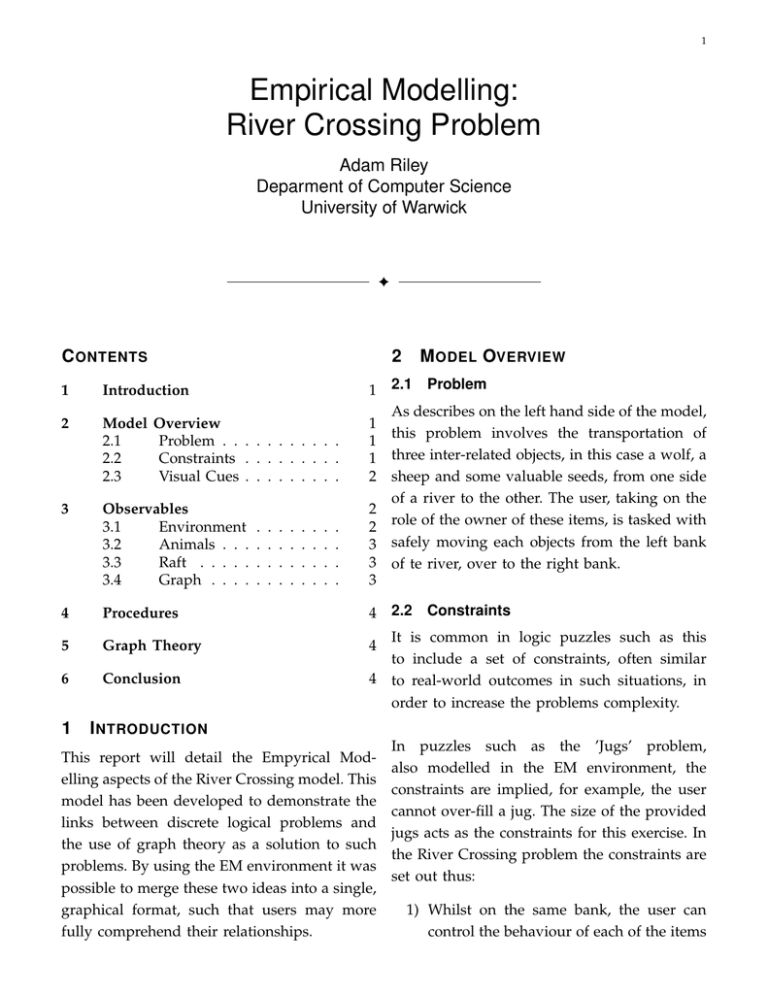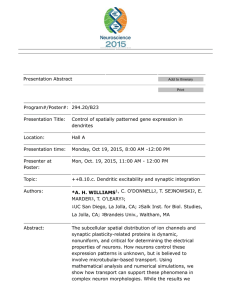Empirical Modelling: River Crossing Problem Adam Riley Deparment of Computer Science
advertisement

1 Empirical Modelling: River Crossing Problem Adam Riley Deparment of Computer Science University of Warwick F 2 C ONTENTS 1 Introduction 2 Model 2.1 2.2 2.3 3 Observables 3.1 Environment 3.2 Animals . . . 3.3 Raft . . . . . 3.4 Graph . . . . 1 Overview Problem . . . . . . . . . . . Constraints . . . . . . . . . Visual Cues . . . . . . . . . . . . . . . . . . . . . . . . . . . . . . . . . . . . . . . . . 2.1 Problem As describes on the left hand side of the model, 1 this problem involves the transportation of 1 1 three inter-related objects, in this case a wolf, a 2 sheep and some valuable seeds, from one side of a river to the other. The user, taking on the 2 2 role of the owner of these items, is tasked with 3 safely moving each objects from the left bank 3 of te river, over to the right bank. 3 4 Procedures 4 5 Graph Theory 4 6 Conclusion 4 1 M ODEL OVERVIEW 2.2 Constraints It is common in logic puzzles such as this to include a set of constraints, often similar to real-world outcomes in such situations, in order to increase the problems complexity. I NTRODUCTION This report will detail the Empyrical Modelling aspects of the River Crossing model. This model has been developed to demonstrate the links between discrete logical problems and the use of graph theory as a solution to such problems. By using the EM environment it was possible to merge these two ideas into a single, graphical format, such that users may more fully comprehend their relationships. In puzzles such as the ’Jugs’ problem, also modelled in the EM environment, the constraints are implied, for example, the user cannot over-fill a jug. The size of the provided jugs acts as the constraints for this exercise. In the River Crossing problem the constraints are set out thus: 1) Whilst on the same bank, the user can control the behaviour of each of the items 2 2) 3) 4) 5) 6) 7) of cargo. Cargo can only be transported when the raft and the cargo are on the same bank. If left alone on the same bank, the wolf will eat the sheep. If left alone on the same bank, the sheep will eat the seeds. The raft used to cross the river can hold only the user and a single piece of cargo. The user may choose to take no cargo across the river on any given trip. The problem is solved once all 3 items of cargo reach the far bank. These contraints form the basis of this problems complexity and, given the discrete number of steps, aloow for the user to compelte the scenario in a finite number of steps. This property of the model makes it suitable for a solution using graph theory. Given the low number of variables in the game, the graph space is small enough to be interpreted easily during gameplay to understand the current state of the environment and all available moves. The raft, used to transport the cargo from one side ot the river to the other, is modelled using a common wodden log structure. This is acheived with a single brown rectangle segmented by black lines at uniform intervals. All interaction by the player is through the use of the five buttons at the top of the screen. Each of these buttons will remain active whilst the player remains in an allowed state. If the use makes an erroneous move, causing one of the pieces of cargo to be destroyed, all buttons except the ’Reset’ button will be rendered inactive. This is to guide the playe through the scenario and ensure that the constraints of the game are met and that a solution is always available. When inactive, these buttons become ’greyed out’ and are visually and physically unavailable to the player. 3 O BSERVABLES As it was built in the js-eden environment, all of the observables are defined in the js-e 2.3 Visual Cues language. This allws for the entire model to be The visual aspect of this model has been defined in a consistent format, without the use designed with simplicity in mind. The of the %scout notation. background environment, representing the river and two banks, is modelled with 3 rectangles. The central rectangle is blue, to 3.1 Environment signify the water, with two green rectangles The environment, as described above, is on either side to represent the banks. modelled using coloured rectangle, to help the user to distinguish between the each of the The 3 pieces of cargo, modelled in this game banks and the river. as a wolf, sheep and seeds, were designed to be recognisable to the user without the The environment is also sized appropriately need for labels. To this end, their shape and for most modern computers to be able to view. colours have been chosen with maximum By sizing the game to be approximately 1024 recognisability in mind. pixels across, there are a very high percentage of monitors able to view the entire screen, and 3 play in their native resolution, allowing for on the game with adjacency. Leaving two maximum accessibility. items of adjacent cargo on a bank unattended will end the game. This allows for a level of 3.2 Animals abstraction. Even if the player were unable Each animal is a compound model, represented to distinguish between the items of cargo, by a compination of shapes in varying sizes they may infer the constraints of the game by and orientations. Using the wolf as an example, observing the positions of the cargo during this animal is comprised of ten observables. their failure states. The combination of these variables is designed to allow the user to associate the final These positions also correspond to the observable with its intended representation, in positions of the buttons used for interaction. The animals are positioned Wolf, Sheep Seeds, this case, of a wolf. running from top to bottom, whilst the buttons This approach has been taken with each are positioned Take Wolf, Take Sheep, Take of the items of cargo such that the user will Seeds, from left to right. This again, allows the be able to distinguish one from another. As player to infer the use of the buttons simply the items of crago are unique and finite, it from their relative positions. is more important for the user to be able to differentiate between each of the items than for them to be accurate representations. For this reason, the animal observables were designed to be a compromise between recognisable and unique. Each animal is also linked to the shared x position vlaues ’animalRight’ and ’animalLeft’ through a position variable. These represent the positions of the animals when on each of the banks. Again, as stated previously, the distinction between the two available states of the animals (’on left bank’ or ’on right bank’) is more important than their relative positioning, therefore it was decided that they should share these variables in order to be consistent. 3.3 Raft Similar to the animal representations, the raft is a compond object comprised of a rectangle and multiple lines. The x position of each of these shapes is also controlled by a shared variable named ’raftPos’. This variable, alternated whenever a successful transfer of cargo (or an empty journey) is completed, moves the raft from a position on the left bank to a position on the right bank and vice versa. 3.4 Graph This area, located at the bottom of the screen, represents the current state of the game, and all legal state transitions such that the goal remains acheivable. If the user makes a transition not signified on the graph as a The placement of these items of cargo is transitions from the green node (curent state) also important. As the constraints of this to an adjacent red node (legal states), the game model state that the items of cargo may be a will terminate with failure. danger to each other, this has been signified 4 The state transition diagram is represented with nodes, depicted as circles, and transitions, depicted as lines. Each line represents a relationship between states which equates to a single button press by the user. The transitions are bi-directional and, as such, are not labelled with arrows. The green node allows the user to identify their current state in the state transition diagram and each adjacent node to the green node, signifies each possible move for them. The player is free to make transitions from left to right and right to left, but the goal state is located on the far right of the state transitions diagram, labelled ’R:R:R:R’. This label, as descirbed in the models legend, signifies that each of the items of cargo and the raft in on the right hand bank, therefore, the game has reached the goal state. 4 P ROCEDURES Due to its simplicity, this game requires procedures only when a button press is made by the player. Each of these procedures is written to ensure that none of the game constraits can be violated and, if that is the case, to either disallow the action, or signify the end of the run and require a reset. This ensures that the player can enter some of the incorrect states available to the game, but connot violate the fundamental rules of the problem, such as using the raft to transport cargo when they do not share a bank. 5 G RAPH T HEORY Is is possible, for all finite state games, to construct a styate transition diagram which details all available ’moves’ that a player can make, and which lead to failure states. This allows players to identify optimum solutions for games and if possible, avoid failure entirely. In small games, such as the one presented here, and similar games, with small nukmbers of possible states, graph theory can rove to be an invaluable approach. This model aims to introduce this relationship to the player by not only providing a partial state transition diagram for the player to view whilst finding a solution, but also identifying the players current state on the diagram as a green node. By presenting the player with the solution in this way, they may more fully understand the inter-relationships of logic problems such as this one, and their corresponding state transition diagrams. 6 C ONCLUSION This model was developed with learning in mind. By visually representing the graph theory which can be used to form a solution to logic problems, users may be able to further understand their use and formulate a similar solution to other problems. The visual cues in the game are designed to be easily distinguished by the players, holding relative positioning and colour as a high priority, such that the player may more asily understand the model and focus on the relationship between the problem and the graph.




